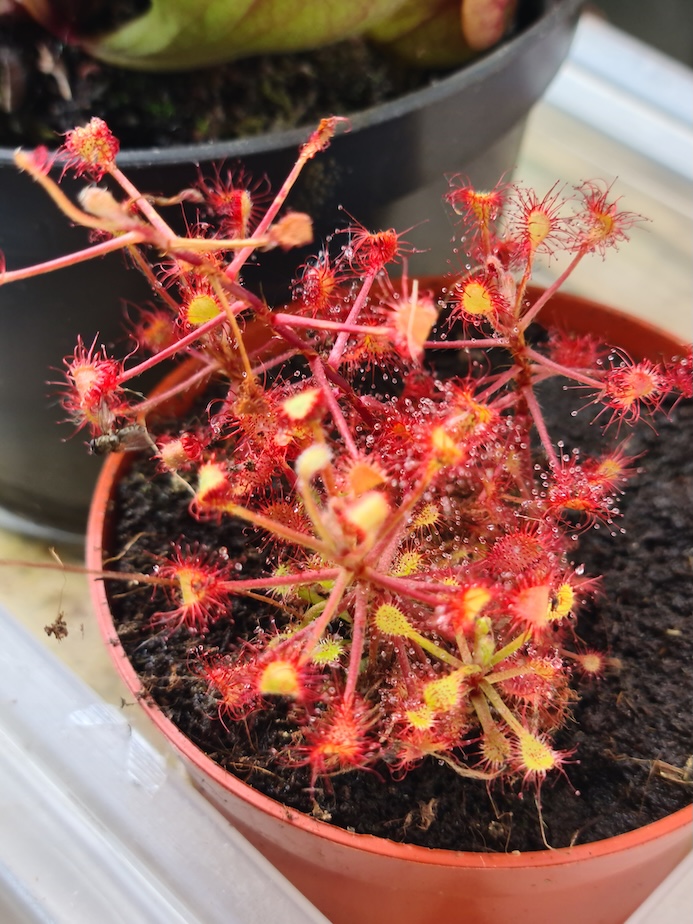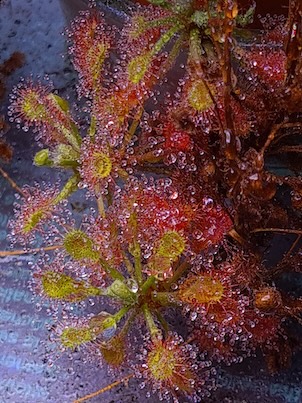


Drosera madagascariensis
General
Drosera madagascariensis, also known as the Madagascar Sundew, is a fascinating carnivorous plant native to Madagascar and parts of tropical Africa. Valued for its elegant, upright stems and beautiful glandular leaves, it has enchanted botanists and hobbyists alike with its insect-trapping prowess and adaptability to cultivation. This species showcases the remarkable diversity found within the Drosera genus and offers a glimpse into the unique strategies plants have evolved to survive in challenging environments.
Physical Characteristics
This sundew stands out among its relatives due to its vertical, vine-like growth habit, typically reaching 10–40 cm (4–16 in) in height. Its leaves are arranged in a spiral along the stem, each lined with vivid red tentacles tipped with glistening mucilage. These dew-like droplets not only lure small insects but also trap and digest them. The overall coloration ranges from bright green to deep red, depending on light exposure and growing conditions. Seasonal pink or white flowers emerge on slender stalks, adding delicate beauty to its overall appearance.
Lifestyle
As a carnivore, this plant supplements its nutrient intake by capturing insects. Sensitive tentacles respond to struggling prey, curling around and securing the meal while digestive enzymes break down the soft tissues. The nutrients absorbed, especially nitrogen and phosphorus, are critical, since the plant inhabits poor, acidic soils. Beyond its predatory exploits, it also photosynthesizes efficiently, striking a balance between carnivory and autotrophy.
Habitat and Protection
In the wild, this sundew thrives in boggy grasslands, seepages, and marsh edges—areas with consistently damp, acidic soils that are low in nutrients. Its distribution covers Madagascar and stretches along the eastern coast of Africa, from Tanzania to South Africa. Habitat loss and over-collection can threaten wild populations, but fortunately, conservation sites and responsible cultivation help to secure its future. When grown outdoors, protection from frost and desiccation is crucial, as this species prefers mild, frost-free climates.
Cultivation
This plant has earned a reputation for being comparatively easy to grow, making it suitable for both beginners and experienced enthusiasts. Its upright habit allows for attractive container displays or inclusion in mixed carnivorous plant arrangements. Seeds germinate readily with warmth and light, and propagation is also possible through cuttings. Given its tropical origins, consistent warmth and humidity are key to success.
Special Features
Few carnivorous species possess such a graceful vertical form. The stem’s ability to grow upright and even recline as it lengthens gives it a distinctive silhouette in collections. Its mucilaginous glands, always shimmering in high humidity or bright light, catch the eye even before its flowers open. It is also notable for its relative ease of propagation—leaf and stem cuttings root with moderate success, providing ample opportunities for sharing and expansion.
Care
Light
Bright, filtered sunlight is preferred. Direct sun is beneficial but should be introduced gradually to avoid leaf burn. In low light, the plant may become leggy and lose its vibrant color.
Temperature
Optimal temperatures range from 20–28°C (68–82°F) during the day, and not falling below 12°C (54°F) at night. It does not tolerate frost or sustained cold.
Water
Always keep the substrate moist, but not waterlogged, using only rainwater, distilled water, or reverse osmosis water. The tray method works well—maintain a shallow pool of water around the pot at all times.
Soil
A mix of sphagnum moss and silica sand or perlite (typically 1:1) is ideal. Never use standard potting soil, compost, or any medium containing fertilizers or minerals.
Nutrition
It gets most of its nutrients from trapped insects. Do not fertilize; additional feeding is unnecessary and can harm the plant. If grown indoors without access to insects, occasional supplementation with small, live or freeze-dried insects is possible.
Humidity
High humidity (above 50%) promotes dewy, healthy leaves and good growth. In dry rooms, consider using a humidity tray, grouping plants, or providing a gentle misting in the morning.
Dormancy
This species does not require a winter dormancy, remaining active year-round if conditions remain warm and bright. Growth may slow slightly in cooler or darker periods, but it should not be forced into dormancy.
Common Problems
Leggy, weak growth
Cause: Insufficient light or overcrowding from neighboring plants.
Solution: Move to a brighter location and thin surrounding vegetation to improve light access.
Leaves lose dew or appear dry
Cause: Low humidity or water with high mineral content.
Solution: Increase ambient humidity and ensure only pure water is used.
Stunted growth or brown roots
Cause: Use of fertilizers or inappropriate soil mix.
Solution: Repot with appropriate carnivorous plant soil (sphagnum moss and sand/perlite, no fertilizer).
Leaf edges curl or blacken
Cause: Exposure to cold drafts or temperatures below 12°C (54°F).
Solution: Relocate to a warmer area and avoid exposing the plant to temperature drops.
Failure to set flower buds
Cause: Insufficient nourishment or inadequate light during the growth period.
Solution: Ensure bright light and allow some insect feeding during active growth.
